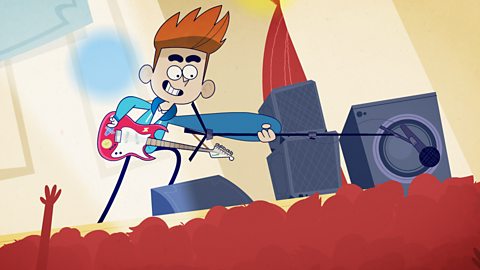What is structure?
When listening to your favourite songs, you might notice there are different sections in each of them.
Structure is the order the different sections of a song or piece of music are played in.
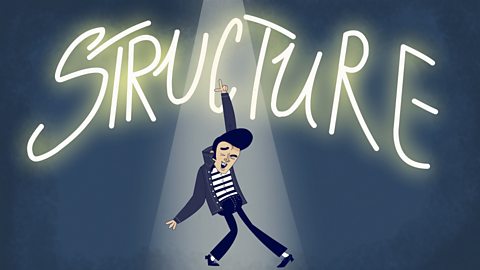
Structure in songs
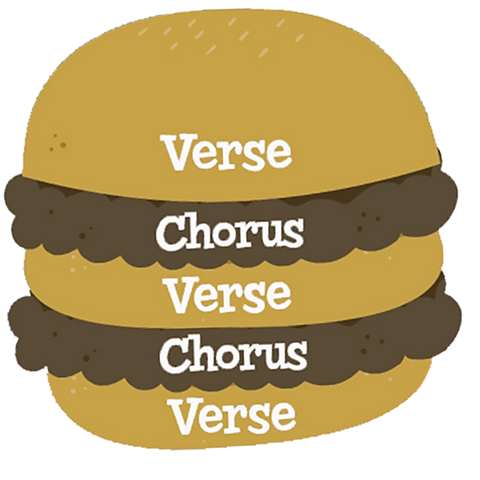
In pop musicMusic that is popular and enjoyed by a large number of people such as the songs played on the radio., songs often follow a verse - chorus - verse structure.
Verses usually come before a chorus. They often repeat but with different lyricsThe words to a song. for each verse.
The chorus is usually a catchy section repeated throughout the song. Every time we get to the chorus, typically the lyrics are the same making it easy to sing along to.
Watch: That's one groovy chorus!
Who better to explain more about structure in popular music, than 'The King' himself Elvis Presley.
GIRL 1: Hmm, so should we put the Bang, bang, boom, boom at the beginning or the end?
BOY 1: May be in the middle?
GIRL 2: Can’t we just repeat it forever? It’s so AWESOME!
BOY 2: Hey, I’ve got some new lyrics. “Our tempos steady like a well times yo-yo.”
GIRL 3: Actually, they’re not bad.
GIRL 1: I like them! Let’s play the song and see if we can fit them in!
MUSIC: # We’re gonna get out with a BANG BANG BOOM BOOM #
ELVIS: Elvis is in the building.
GIRL 3: Here we go again.
ELVIS: That’s one groovy chorus, baby.
BOY 1: It’s good, but where do we put it in the song?
ELVIS: Hey! A little less conversation, a little more action! Sing me that chorus again will you?
BOY 1: # We’re gonna go out with a bang bang boom boom. #
ELVIS: Woah, that’s catchy! And if you repeat the catchy bit you get a hit! # You ain’t nothing but a hound dog, cryin’ all the time. REPEAT! You ain’t nothing but a hound dog, cryin’ all the time.
BOY 2: Hey, that’s catchy!
ELVIS: # Well, you ain’t never caught a rabbit and you ain’t no friend of mine. # It’s your go, Ed.
BOY 1: # We’re gonna go out with a bang bang boom boom. #
ELVIS: Repeat it, baby!
BOY 2: # Bang bang boom boom! #
ELVIS: Now you’re making it really catchy!
GIRL 2: # Bang bang boom boom!
ELVIS: That’s one catchy chorus.
ALL: # BANG BANG BOOM BOOM!
ELVIS: Now for a little thing I like to call… STRUCTURE! The structure is like making a cake. You got the ingredients, you just got to know what order to put them in the bowl.
BOY 2: Well, we could use my yo-yo lyrics for the verse.
GIRL 2: And then we have a chorus!
ELVIS: Verse. Chorus. Now your song has two sections.
BOY 1: We could add another verse.
ELVIS: Yeah baby!
GIRL 2: What about repeating the catchy chorus?
GIRL 1: Let’s do it! Start with the verse, then the chorus, verse then the chorus then another verse!
GIRL 3: But if we keep repeating the same chorus and verse, isn’t that like… kinda boring?
ELVIS: Uhuh. But we can add another lil’ trick to shake it up. Milkshake!
GIRL 2: Awesome!
BOY 1: What?!
GIRL 1: You’re the kind Elvis!
ELVIS: Aw, thank you very much.
Elvis wasn't really a king, it was just his nickname.
People still call him ‘The King of Rock and Roll’ or simply ‘The King’.
Watch: Verse - chorus - verse
If you’re writing your own song or creating one with friends, explore how using verses and choruses can make your song really catchy!
Mr Smith: Popular music often follows a verse-chorus structure. Let’s use these bricks to demonstrate it.
Mwaksy: These one’s say verse, and these say chorus.
Mr Smith: Yeah now pop songs often start with a verse first.
Mwaksy: Hmm, i’ll put this here first then.
Mr Smith: Yep, and then next they tend to have a bit of a catchy chorus.
Mwaksy: Okay, there we go. What’s next?
Mr Smith: Well, we can repeat that pattern again by adding another verse and then another chorus after that.
Mwaksy: Okay. Verse and chorus. Done!
Mwaksy: And the second verse can be a bit different front the. first verse right? The lyrics will change?
Mr Smith: Yeah, that’s right. Most of the time the chorus stays the same when it’s repeated, but the lyrics of the verses often change from the first to the second verse.
Mwaksy: Okay, i’ll add a 1 to this one then, and now i’ll add a 2 to this one as well.
Mwaksy: We now have verse one and verse two, so does this pattern just continue? Should i add a third verse and a chorus?
Mr Smith: Hmm, well actually there are other sections of a song that we haven’t even looked at yet. Now if we kept repeating this pattern of verse, chorus, verse, chorus what do you think would happen?
Mwaksy: Uh, we’d run out of bricks for a start. But I guess the song might sound a bit samey, repetitive.
Mr Smith: Yeah, exactly that. And that’s where the bridge comes in. Now the bridge of a song helps to mix the song up a bit. It can sound quite different from the other sections of the song.
Mwaksy: Ah, i’ve got a bridge here, that comes next?
Mr Smith: Yeah, you can put that there yeah, but there is no strict order but typically a bridge would follow a second chorus. As we said it’s a chance to change something up a bit within the song. Maybe the bridge would have different chords, or maybe a new tune, or even new lyrics. Hey you could even have an instrumental solo in a bridge too.
Mwaksy: Why is it called a bridge?
Mr Smith: Well just like a bridge in real life in music a bridge can actually help connect things together. If we add a bridge to a song it can connect two different sections like a verse and a chorus.
Mwaksy: There we go that bridge mixes up the song a bit. So how do we end the song?
Mr Smith: Well can you think of how lots of popular songs end?
Mwaksy: Don’t they keep singing the chorus again and again and again and again?
Mr Smith: Yes, that’s right yes. Again songs can have lots of different structures but a popular way to end pop songs is just to repeat the chorus a few times over.
Mwaksy: I’ll just add two, as I don’t have space for many more. And that’s that then. A perfect pop song structure. Would this have chart topper all over it?
Mr Smith: Oh, absolutely yeah. Hey does that actually help with your song?
Mwaksy: Let me see, hmm. Oooh! I think it might, this is cool. Make sure you have a go at writing your own pop song and adding verses, choruses and bridges. Play around with the structure and see which works best for your song.
What is call and response?
Call and response is like having a musical conversation. It can be sung or played on instruments.
A short melodyDifferent pitched notes played one after another making a tune. or rhythmA pattern of sounds of different durations. is played, this is the call.
This is then immediately answered by a different melody or rhythm, this is the response.
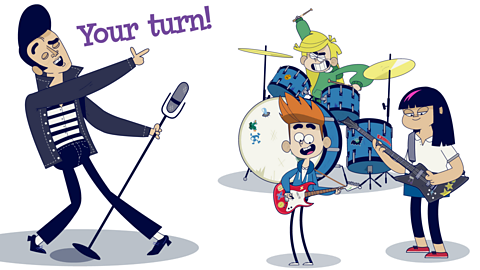
Call and response comes from traditional African music.
It's used in gospel music when a choir leader sings a line as the call. The rest of the choir then sings the response back together.
Activities
Call and response game
With friends or family members, practice some call and response rhythms. You can play it with or without instruments.
- Over a steady beat (pulse), the first person claps or plays a rhythm. This is the call.
- The second player immediately responds by clapping or playing a new rhythm.
- Keep going and enjoy listening to each others call and response rhythms!
Quiz
SATs preparation resources. activitySATs preparation resources
Get ready for the SATs papers with videos, activities, quizzes and games to refresh your knowledge and practise your skills.

More on Music
Find out more by working through a topic
- count16 of 20
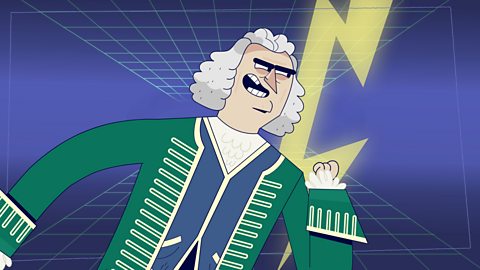
- count17 of 20
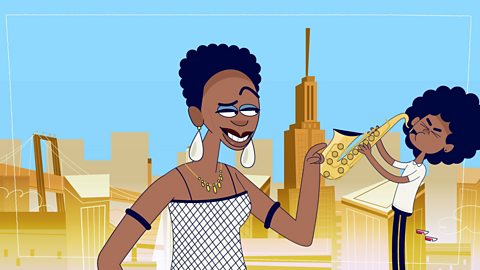
- count18 of 20
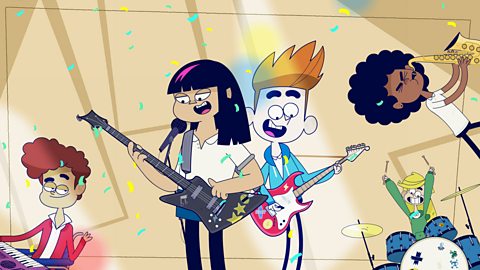
- count19 of 20
